Silence as the Technology of the Soul
In an age where every empty moment is filled with notifications, messages, and background noise, silence has become a forgotten luxury. Yet recent research and a growing number of personal accounts are converging on one essential truth: silence is not the absence of sound, but a state of presence — a technology of the soul.
A 2025 study from Harvard Medical School revealed that just two hours of daily quiet — not necessarily meditation, simply the absence of artificial noise — can enhance connectivity between brain regions involved in memory and emotional regulation. When external stimuli fade, the brain doesn’t switch off; it reorganizes. Scientists call it a phase of “synaptic housekeeping,” where scattered impressions and sensory overload are quietly sorted and integrated.
Psychologists are beginning to frame this as a form of “silence hygiene” — a mental detox for the overstimulated age. Much like intermittent fasting for the body, it’s a cognitive fast for the mind. After only a few days of practice, participants describe subtle but powerful shifts: time feels slower, thoughts gain depth, emotions regain definition.
Nature, unsurprisingly, is the most effective teacher. Studies conducted in Scandinavia and Japan have shown that natural soundscapes — wind, water, the rustle of leaves — don’t disrupt silence but deepen it. Researchers call it active silence: a state where the body relaxes and the mind remains alert. Urban designers are starting to translate this insight into reality, creating “quiet gardens” and “mental silence rooms” to offer refuge from digital saturation.
But silence is not only therapeutic. It can also be a cultural act — and sometimes, a form of resistance. In a world obsessed with expression, where every thought seeks an audience, choosing not to speak becomes an assertion of freedom. Philosopher Byung-Chul Han has written that “silence is the condition for every form of genuine thought.” Without silence, there is no listening. Without listening, there is no inner clarity.
Across spiritual traditions — from the Christian deserts to Zen monasteries — silence has always marked the threshold of deeper awareness. Yet today, it’s being rediscovered in secular terms, as a tool for focus and emotional repair. In an economy that values output above all else, stillness becomes a quiet rebellion.
Many modern retreat centers now use periods of silence not as ascetic discipline, but as psychological inquiry. Participants are invited to observe what happens when speech falls away. How much of our talking is truly communication, and how much is camouflage — a defense against meeting ourselves in the open space that words usually fill?
That question, perhaps, is the point. Silence is not empty; it’s a medium of perception, an ancient intelligence we have forgotten how to hear. When everything else falls quiet, what remains is not nothing — it is a clarity that feels strangely alive. And in that moment, fragile yet unmistakable, many say they finally meet something real.
A 2025 study from Harvard Medical School revealed that just two hours of daily quiet — not necessarily meditation, simply the absence of artificial noise — can enhance connectivity between brain regions involved in memory and emotional regulation. When external stimuli fade, the brain doesn’t switch off; it reorganizes. Scientists call it a phase of “synaptic housekeeping,” where scattered impressions and sensory overload are quietly sorted and integrated.
Psychologists are beginning to frame this as a form of “silence hygiene” — a mental detox for the overstimulated age. Much like intermittent fasting for the body, it’s a cognitive fast for the mind. After only a few days of practice, participants describe subtle but powerful shifts: time feels slower, thoughts gain depth, emotions regain definition.
Nature, unsurprisingly, is the most effective teacher. Studies conducted in Scandinavia and Japan have shown that natural soundscapes — wind, water, the rustle of leaves — don’t disrupt silence but deepen it. Researchers call it active silence: a state where the body relaxes and the mind remains alert. Urban designers are starting to translate this insight into reality, creating “quiet gardens” and “mental silence rooms” to offer refuge from digital saturation.
But silence is not only therapeutic. It can also be a cultural act — and sometimes, a form of resistance. In a world obsessed with expression, where every thought seeks an audience, choosing not to speak becomes an assertion of freedom. Philosopher Byung-Chul Han has written that “silence is the condition for every form of genuine thought.” Without silence, there is no listening. Without listening, there is no inner clarity.
Across spiritual traditions — from the Christian deserts to Zen monasteries — silence has always marked the threshold of deeper awareness. Yet today, it’s being rediscovered in secular terms, as a tool for focus and emotional repair. In an economy that values output above all else, stillness becomes a quiet rebellion.
Many modern retreat centers now use periods of silence not as ascetic discipline, but as psychological inquiry. Participants are invited to observe what happens when speech falls away. How much of our talking is truly communication, and how much is camouflage — a defense against meeting ourselves in the open space that words usually fill?
That question, perhaps, is the point. Silence is not empty; it’s a medium of perception, an ancient intelligence we have forgotten how to hear. When everything else falls quiet, what remains is not nothing — it is a clarity that feels strangely alive. And in that moment, fragile yet unmistakable, many say they finally meet something real.



